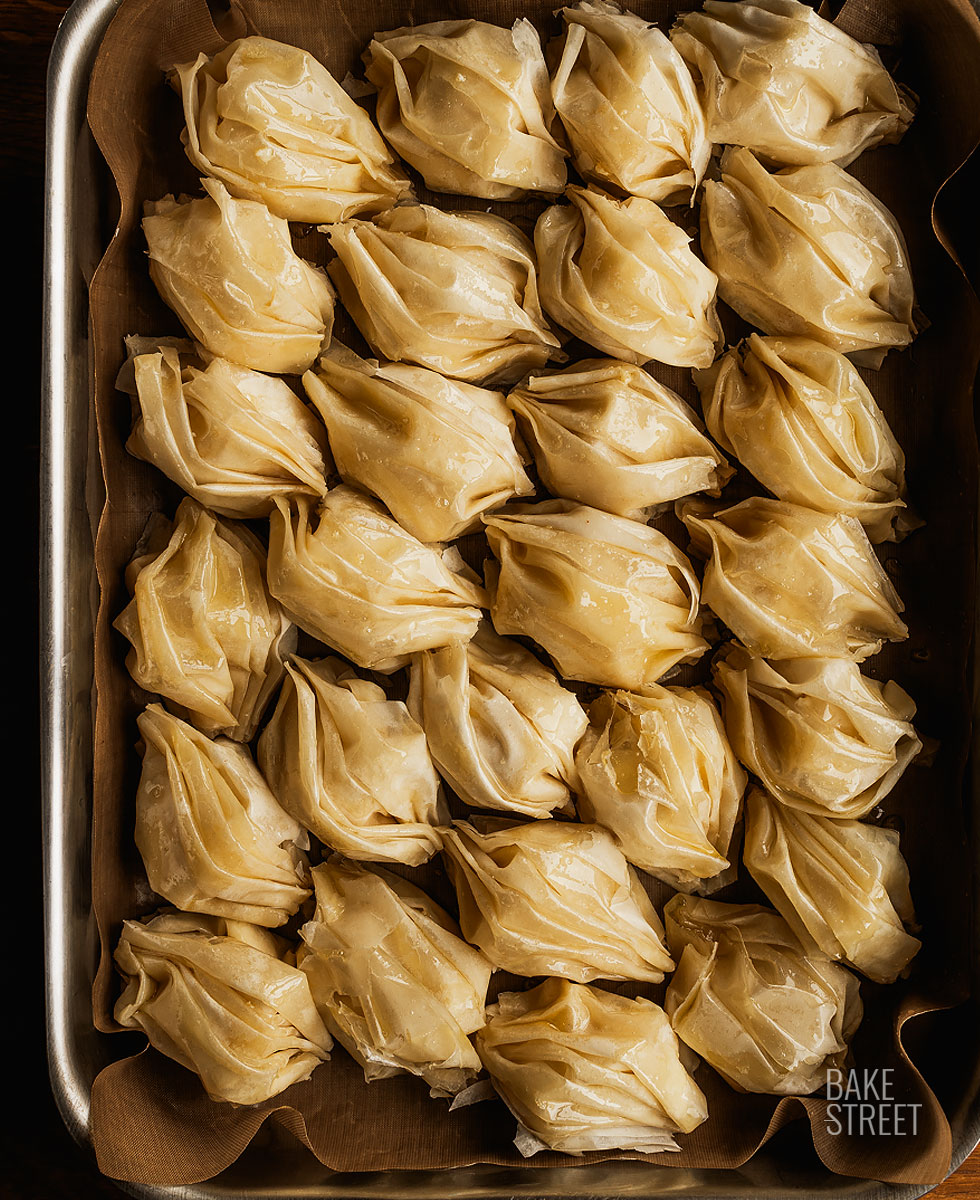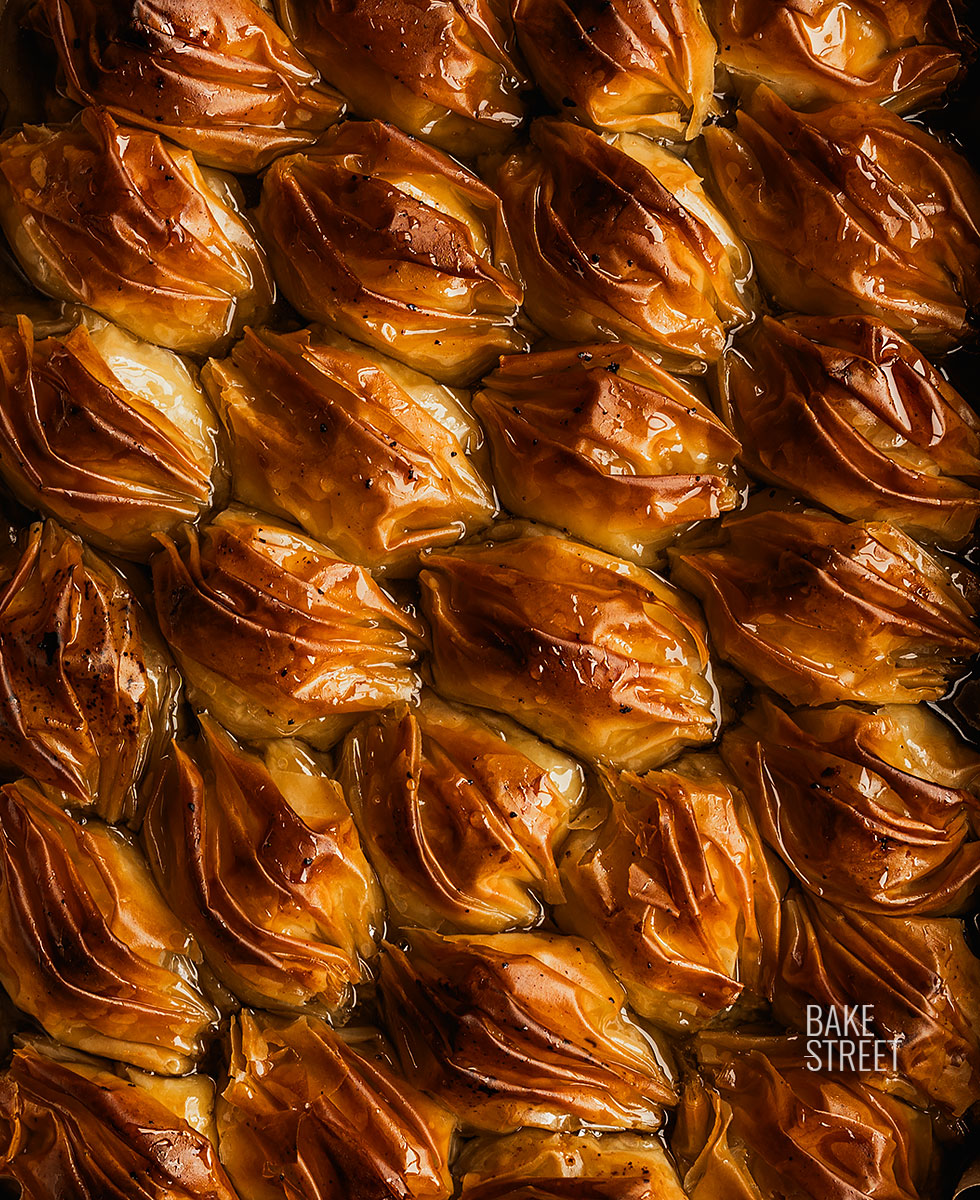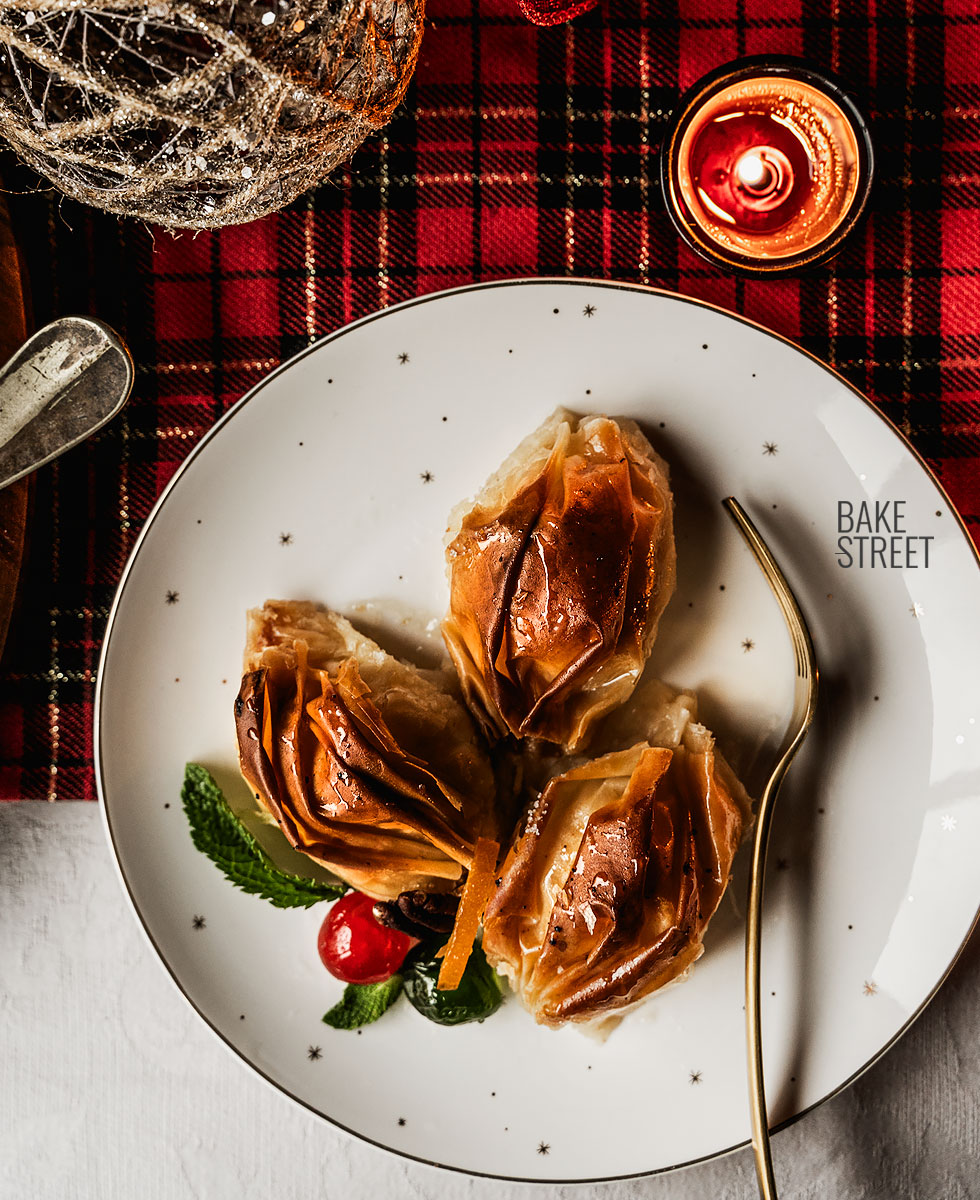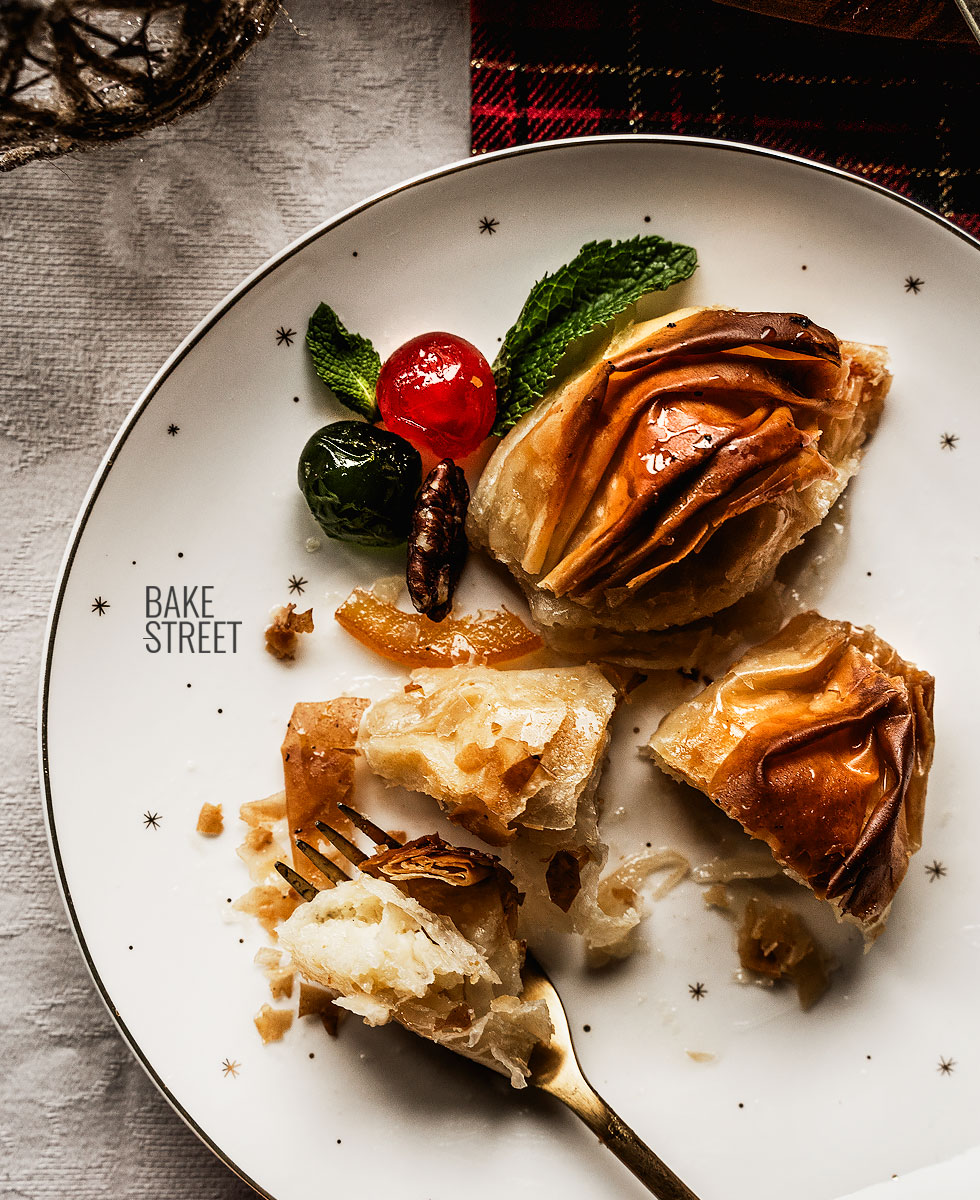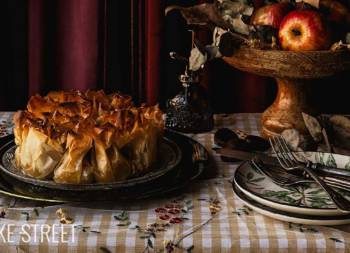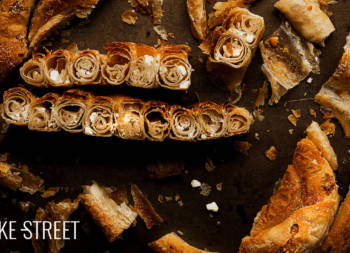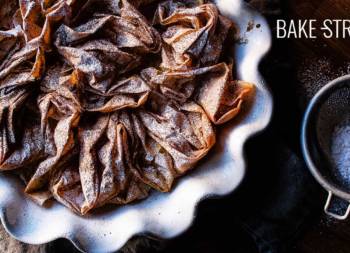
Galaktoboureko, Christmas wreath
I have had this recipe saved for a little less than a year and I was looking forward to this time of year to be able to share it with you all. It is a very easy and attractive dessert, Galaktoboureko, Christmas wreath. A proposal that combines two preparations; on the one hand the famous Greek dessert galaktobourekoand on the other hand the beautiful mussel-shaped baklava.
Before I continue, I would like to thank Antoniou Fillo who is the creator of this beautiful preparation and who, thanks to his work, I have been able to give you this version of his recipe. The presentation is the same as his, but I modified the cream filling and the final decoration. Don’t miss his wonderful work.
Galaktoboureko origin.
Galaktoboureko, “γαλακτομπούρεκο“, has its roots in the Greek pastry tradition and has become a classic of Hellenic cuisine.
Hellenic cuisine, also known as Greek cuisine, is the traditional cuisine of Greece. It is characterised by the use of fresh and healthy ingredients, as well as the influence of various cultures that have left their mark on the region over the centuries. Some of the ingredients that stand out in its gastronomy are olive oil, spices and aromatic herbs, dairy products, vegetables, fish and seafood, honey and fruits, among others. Hellenic cuisine reflects the culture, history and geography of Greece, and has influenced many other cuisines around the world.

Its exact origin is not precisely documented, but it is believed that the dessert developed and became popular on the Greek mainland and islands during the 20th century. The name ‘galaktoboureko‘ suggests a connection to the Ottoman pastry roots that influenced Greek cuisine over the centuries. The Greek words ‘gala‘ meaning milk, and ‘boureko‘ referring to a type of filo dough. Therefore, ‘galaktoboureko‘ could be translated as ‘milk cake in filo dough‘.
Pastry cream is made with semolina, which was common in Greek villages as refined flour was not readily available. At that time, this cream was made only with semolina, milk and sugar. So the end result was somewhat less dense.
Refined flour was used to make special products for special occasions such as breads, cakes, festive biscuits or phyllo dough.
Corn starch, used in this type of creams as a thickener, was introduced to Europe in the 19th century. It was through the expansion of trade and cultural exchanges that foodstuffs, including corn starch, began to reach Europe from other parts of the world. Its popularity grew rapidly due to its versatility and thickening properties, becoming a very common ingredient in European cuisine.
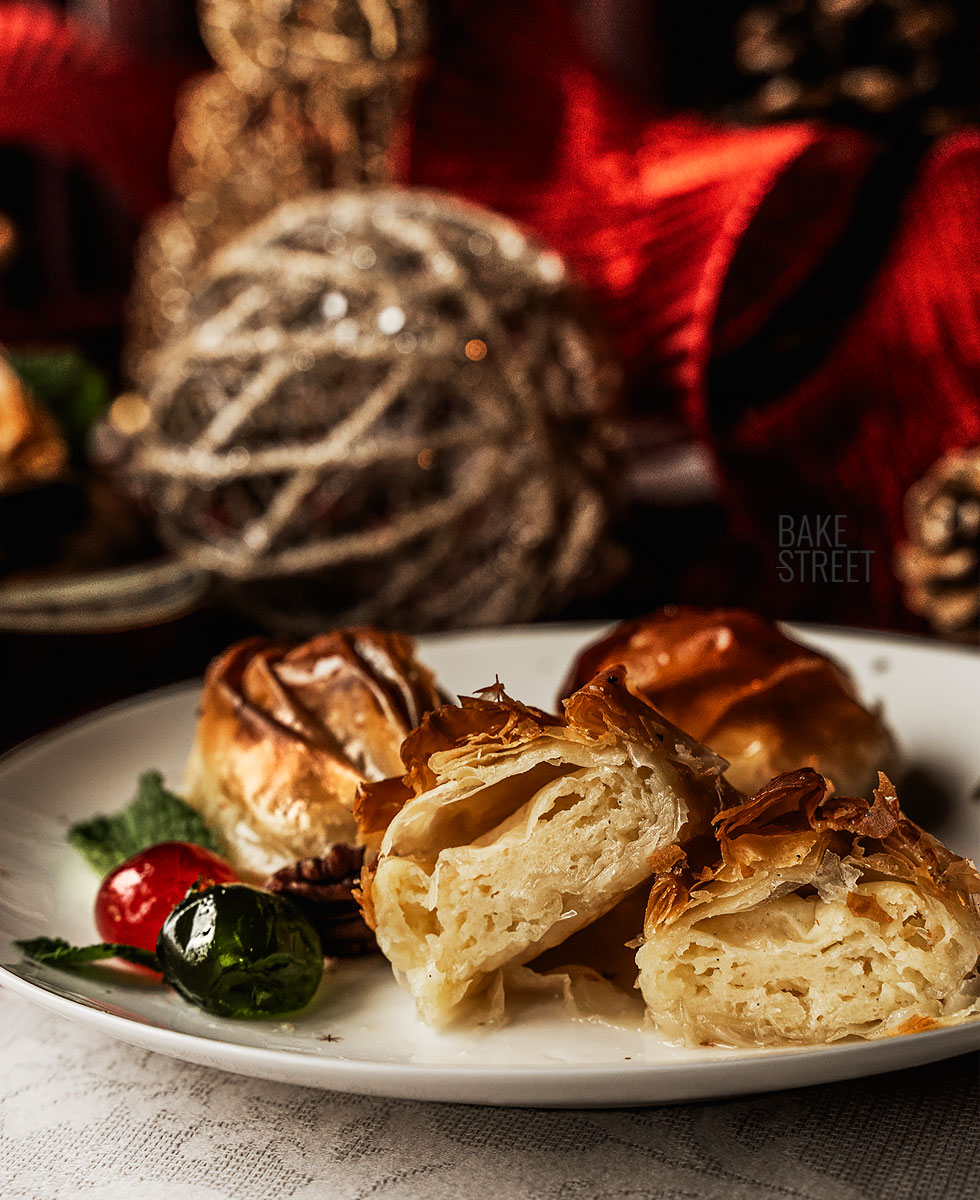
Not to be confused with this Turkish delicacy…
In Turkey there is a similar preparation known as Laz böreği. It is a traditional dish associated with the Black Sea coastal region, home to the Laz community, an ethnic group living mainly in the northeastern coastal region of Turkey.
‘Laz böreği‘ is a variant of ‘börek‘, a type of savoury pastry of Turkish origin consisting of thin layers of filo dough and a filling that can include cheese, spinach, meat, potatoes or other options. There is also a sweet version made with a milk cream or sometimes rice cream, known as muhalabia (I showed you how to make it in the Egypcian Lenza recipe). The dough is very similar to filo dough, known as yufka.
Thanks to the multicultural structure of the Ottoman Empire, this cake was adopted by many ethnic groups living in the empire. For this reason, the Greeks called what they made ‘galaktoboureko‘, also known as milk cake.
It is very difficult to find the oldest recipe for Laz pastries. The most expert confectioners in the Topkapı Palace kitchen shared their recipes, but unfortunately not all of them contain information about their production process. It is said that Laz cake was added to the list of desserts served in the Ottoman palace in the 16th century as ‘seker pastry‘.
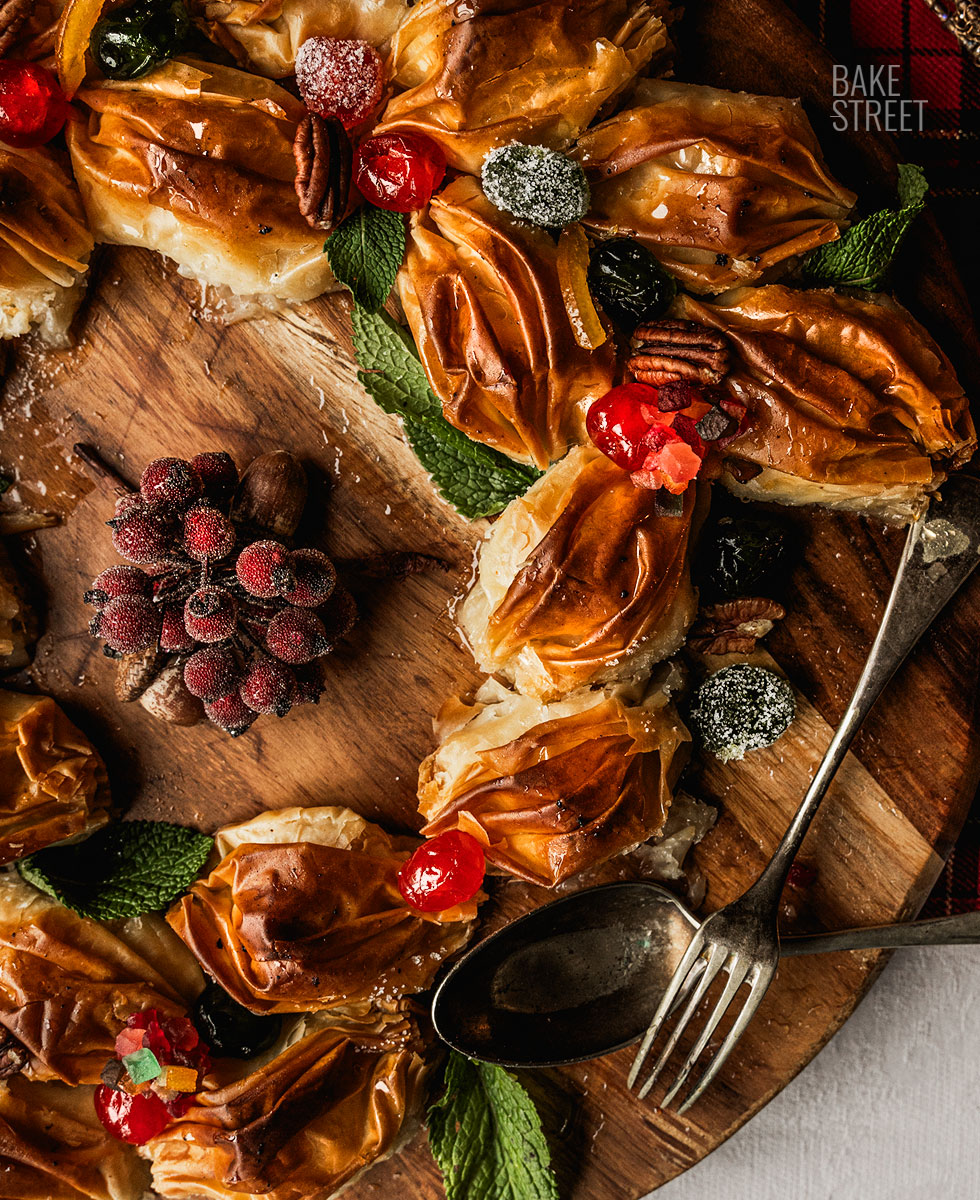
Making galaktoboureko.
The process of making galaktoboureko involves combining thin layers of filo pastry with a semolina and milk cream. The latter is usually flavoured with vanilla or lemon peel to give it a distinctive touch. It is then baked to a crisp, golden colour and finally generously bathed in a syrup or syrup.
This dessert has become a popular choice at festive events, family celebrations and during Greek festivals. Its sweet taste, as one would expect from the process, and its unique texture have contributed to its success in achieving a prominent place in Greek pastry making. Each region and family has its own variations on the recipe, but the essence of galaktoboureko remains the same: an irresistible delight that celebrates Greece’s rich culinary heritage.
Recipe Galaktoboureko, Christmas wreath
SYRUP:
- 225 g water
- 385 g sugar
- 1 Tbsp honey, I used lemon-ginger creamed honey
- peel of one lemon
- 1 Tbsp lemon juice
- 1 cinnamon stick
SEMOLINA CREAM:
- 115 g semolina
- 15 g corn starch
- 700 g whole milk
- 145 g sugar, divided into 2 parts
- 30 g unsalted butter
- 1 teaspoon vanilla extract
- 2 medium eggs
GALAKTOBOUREKO:
- 500 g filo pastry
- 230-250 g unsalted butter, melted and tempered
- all the semolina cream
DECORATION:
- green and red candied cherries
- candied fruits
- pecans
- mint leaves
MATERIAL WE WILL NEED AND SHOWN IN THE VIDEO:
- digital kitchen scale
- saucepan, this is mine from DeBuyer*
- peeler
- whisk
- silicone spatula
- large saucepan, this is mine from De Buyer 28 cm diameter* or medium pot
- bowls
- colander
- pastry brush
- pastry bag, optional
- knife
- large baking tray + Teflon sheet
- large spoon*
- wooden juicer, optional
- precision tweezers*, optional
*You have a 5% discount on the website Claudia&Julia using this code BAKESTREET. Delivers throughout Europe.
Instructions
Prepare syrup.
- In a saucepan, add the sugar, water, lemon peel, lemon juice, cinnamon stick and honey.
- Place over medium-high heat and bring to the boil.
- At this point, reduce heat to low and cook for 5 minutes.
- Remove from heat and allow to cool completely.
- NOTE: Do not remove the lemon peel and cinnamon until needed, as the syrup will infuse with these elements.
Prepare semolina cream.
- In a large saucepan or medium pot, combine the butter with half of the sugar and the milk. Place over medium-high heat and bring to a gentle boil.
- While the milk is heating, mix the semolina together with the cornstarch. Mixing the two ingredients together helps them to integrate better into the milk and prevents lumps from forming.
- Once it reaches a gentle boil, add the vanilla. Reduce to medium-low heat and stir in the semolina mixture.
- Stir the mixture constantly with a whisk until it thickens. This should take about 10 minutes.
- Once the mixture has thickened to a dense porridge-like consistency (as shown in the video), pass the cream through a sieve. This step is not required, but I like to do it to remove any lumps that may have formed.
- Cover the bowl with cling film and leave to cool completely.

Whip the eggs into a ribbon stage and add to the cream.
- In the bowl of the stand mixer add the eggs and the remaining half of the sugar.
- Whisk on medium-high speed until you obtain the ribbon stage or "monter au ruban" in French. You should beat the eggs until they are whitish in colour, with a voluminous texture and fall evenly and continuously, like a ribbon or string. The process can take 10-15 minutes.
- Fold the whipped eggs into the semolina cream, which should have cooled completely.
- Do this in 2-3 batches, mixing very well with the help of a silicone spatula to integrate both elements completely.
- If you wish, pour the semolina cream into a piping bag to make it easier to pipe.
Assemble galaktoboureko.
- For every 3 cakes, you need two sheets of filo pastry.
- Brush the surface of one filo pastry sheet with melted butter. Place another filo pastry sheet on top of this one, making sure that they are as close together as possible.
- Brush the surface again with melted butter.
- On the narrowest part of the filo dough pieces, pipe 3 small quantities of the semolina cream.
- Close the dough by folding it over and covering the filling. Tighten the gaps between the filling and the sides.
- Fold the dough back over itself once more and fold over the two ends of the sides (just enough to seal both sides).
- Finally, fold the remaining dough into an accordion shape and place it on top of the dough with the filling.
- Cut into 3 parts and seal the ends, trying to give a "Marquise" carving shape.
- Repeat the same process with the rest of the dough and filling,
- NOTE: You can see this part much better in the video.

Bake.
- Preheat the oven to 356ºF/180ºC, heat up and down.
- Line a large baking tray with a teflon sheet, this step may not be necessary, but in my case I did it to ensure that the pieces would unmould perfectly after baking and resting in the syrup.
- Place all the pieces in the tray, in my case there were 27 pieces.
- Brush the entire surface with melted butter.
- Bake for 45-50 minutes. I recommend checking the baking time after 40 minutes to avoid over-browning. If you notice that the base is still bubbling with butter, but the surface of the cakes is golden brown, reduce the temperature to 320ºF/160°C and leave for a few more minutes (or cover the surface with aluminium foil). The cakes are ready when there is little butter bubbling on the base.
Cover with syrup.
- Remove the lemon peel and cinnamon stick from the syrup.
- After removing the cakes from the oven, then while they are still very hot, cover the surface of the cakes with the syrup. In my case I used a ladle to make sure they were all covered with it, but you can pour it directly if you prefer. You should incorporate all the syrup.
- Leave to stand at room temperature for 1-2 hours. After this time, cover with cling film and refrigerate for 8-12 hours. It is important to let the cakes sit in the syrup so that they soak well, in fact almost all of the syrup will be absorbed.
- NOTE: It is very important that the syrup is cold, room temperature, and the pastries are hot, just out of the oven, when you pour it in so that the surface of the filo pastry stays crispy.

Form the Christmas wreath.
- To serve the wreath you can use a platter, large plate or wooden board. You can also serve it in a different shape if you wish.
- Carefully separate each piece and place in a wreath shape.
- Decorate the surface as you like, in my case I have used green and red candied cherries (some of them covered with sugar), candied fruits, pecans and mint leaves.
- Serve.

Notes
- Traditionally, this syrup does not contain honey. In my case, I decided to add a spoonful to add the flavour and aroma of this ingredient. I also used a creamed honey with lemon and ginger. You can use normal honey or omit it if you prefer.
- Originally, semolina cream recipe does not contain corn starch. This addition allows us to achieve a thicker cream, without the need to use a lot of egg.
- It is important to mix the filling very well when you are cooking it, otherwise lumps will form very easily. Be patient in the cooking process, do not increase the heat to speed up the thickening process.
- Let semolina cream cool completely before integrating the whipped eggs.
- In my case I used bought filo dough, but if you want to make it at home, in this post I show you how to make homemade filo dough.

- The shaping of these pastries is simple, but it requires two points for everything to go well; that the dough is not too long in the air to prevent it from drying out and do not brush it too much with butter. Both will result in the dough cracking or falling apart easily. If this happens, we will suffer a little when forming the accordion.
- As they come out of the oven, you should cover the cakes with the syrup so that they are very well soaked. The syrup should have cooled completely and the cakes should be warm so that the filo pastry remains crisp when poured.
- These pastries should ideally rest for 8-12 hours in the fridge to achieve the perfect texture. If this is not possible, let them rest for at least 2 hours at room temperature before serving.
- The texture of these cakes, after resting in the fridge, is; very crunchy on the surface, creamy inside and very moist on the base. After the first day, the top crispness is lost. The taste and texture/consistency of the base reminds me slightly of the puff pastries from Astorga.
- They keep for 3-4 days in the fridge in an airtight container.

If you want to surprise this Christmas with a dessert that is different, but above all, easy to make, keep in mind this Christmas wreath inspired by the wonderful Galaktoboureko. It won't take long to make, it can be made in advance before assembling it for presentation and it is made with very inexpensive ingredients. Not to mention the result is outstanding!
A different, crunchy, moist snack with that "I don't know what" that hooks you and makes you fall in love at the same time. You can decorate the wreath with whatever you like, either the option I've left you with or fresh fruit; raspberries, redcurrants, blackberries... Some sweetened rosemary sprigs would look lovely. I wanted to use them... But I couldn't find them in time.
I hope you will try it and let me know what you think!
By the way, I remind you that you can watch all my videos on my YouTube channel. If you subscribe and turn on the little bell, I will be eternally grateful!
I wish you a wonderful Sunday afternoon!
Lots of love,
Eva
Sources: Dishes Origins
This post contains affiliated links.

